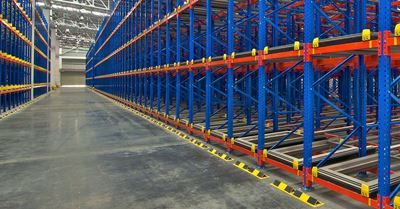Push Back Rack | San Diego

Raymond West offers pushback rack in a variety of styles and capacities.
We are one of the largest industrial racking suppliers in the state.
Call us today at (858) 679-1800
What Is Push Back Racking?
Push back racking (sometimes referred to pushback rack) is a high density pallet storage approach that allows pallets to be stored anywhere from 2 to 6 units deep. Pallets ride on linked carts that travel up a gradual slope as units are loaded, or “pushed back” from the face of the racking system.
When products are later removed, the pallet adjacent to the first position pallet slips back down the gradient to the facing slot.
Push Back Rack Advantages And Disadvantages
Pushback rack is excellent for certain operations, but isn’t appropriate for all warehouses. There are several benefits and drawbacks to investigate.
Higher Density Storage
Because push back pallet racks can store anywhere from 2-6 pallets in any particular position, they can reclaim between 1-5 aisles, which represents an enormous chunk of warehouse space.
Less Forklift Travel
When aisle numbers are reduced, forklifts don’t have to make as many trips, saving time and equipment wear. Reduced forklift traffic also makes a safer environment within the warehouse. Fewer trips directly correlates to fewer collisions.
Greater Selectivity
Pushback rack offers a nearly perfect mixture of selectivity and storage efficiency. Different from drive-in rack, where whole storage bays are usually only one SKU, push back features straightforward access to many more pallet positions from the rack front.
LIFO Configuration
Dissimilar to pallet flow rack, which is a First In First Out (FIFO) type of system, push back rack is a Last In First Out (LIFO) style of storage. This means that it’s not ideal for goods that are perishable, because products that are loaded early can sit for long periods of time as inventory is loaded and removed at the front of the lane.
How Does Push Back Racking Work?
Push back rack configurations include a couple of tracks declining toward the aisle and a set of nested carts which move on these rails.
An initial pallet is added on the uppermost cart by a lift truck. When another pallet is added, the forklift operator pushes the first pallet back and places the next pallet on the adjacent cart. The final pallet positioned in the lane sits on the tracks.
As push back rack is unloaded, shuttles of unit loads glide down the tracks. Lift truck drivers pull each pallet sequentially until the lane is empty, or supplement additional pallets, filling the lane back up.
Push Back Pallet Racking For Sale
For more information on push back racking options, get in touch with a material handling professional at Raymond West today. Our warehouse design experts can help you develop a solution that is perfect for your operation.
Raymond West's San Diego facility serves all of San Diego County, including Carlsbad, Chula Vista, Downtown, El Cajon, Escondido, Fenton Carroll Canyon, Grantville, Kearney Mesa, Levanto, Morena, National City, Oceanside, Otay, Otay Mesa, Poway, San Marcos, Santee, Sorrento Mesa, Spring Valley, Vista and all surrounding areas.
Raymond West | San Diego Material Handling Equipment Supplier
8221 Arjons Dr # B2
San Diego, CA 92126
(858) 679-1800

